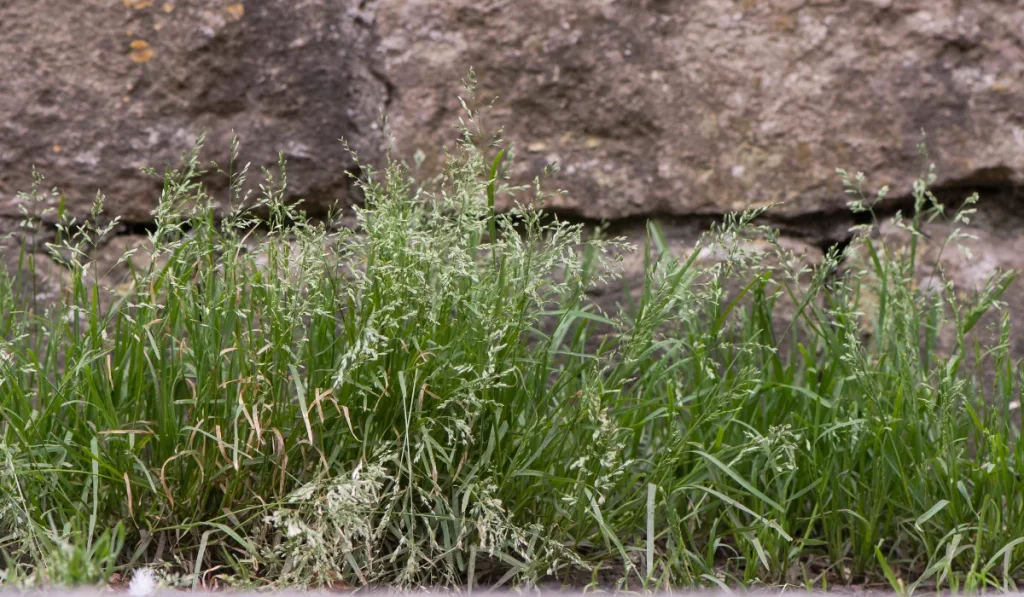Is your lawn looking more like a jungle than a pristine yard? Many homeowners struggle to distinguish between a healthy lawn and unwanted weeds that mimic the look of grass. These sneaky growths can invade your space and take nutrients for your desired grass.
Read on and learn how to spot these imposters and maintain a lush lawn.
Key Takeaways
- Grass-like weeds like crabgrass, nutsedge, and quackgrass mimic turfgrass but compete for essential nutrients and sunlight.
- Identifying weed traits like growth patterns, blade texture, and color helps distinguish them from healthy lawn grass.
- Selective herbicides, such as pre- and post-emergent types, effectively control weeds without harming your lawn.
- Healthy lawn care practices and consulting with lawn care experts can prevent weeds and support lush grass growth.
1. Crabgrass

Crabgrass, or Digitaria, is an annual broadleaf weed germinating in late spring. Its coarse blades spread low and wide, forming a dense mat. It often thrives in sunny, bare patches of a lawn. This weed grows quickly and aggressively, outcompeting desirable grass. Commonly found along edges and sidewalks, it matures by summer.
2. Nutsedge or Nutgrass

Nutsedge, also called nutgrass, is a perennial grass-like lawn weed. Unlike true grasses, it features triangular stems and grows taller than most lawn grasses. It thrives in moist soils and produces yellow flowers. Nutsedge spreads through underground tubers and rhizomes.
3. Quackgrass
Quackgrass is a resilient perennial grassy weed with coarse, flat leaves. Its leaf blades have a bluish-green hue and are distinguishably rough. It spreads through long rhizomes, making it hard to control. This weed prefers fertile, well-drained soil and can survive in various conditions.
4. Goosegrass
Goosegrass grows with a distinctive starlike shape, with flattened stems that radiate from a central point. This warm-season annual weed thrives in compacted soils and is common in athletic fields and along pathways. It forms low, dense clumps that suppress other turf species.
5. Dallisgrass
Dallisgrass is a perennial weed notable for its coarse texture and fast growth. It features broad, flat blades that contrast with finer turfgrass. This weed spreads through short rhizomes and seed heads. It commonly invades lawns, fields, and disturbed areas.
6. Annual Bluegrass

Annual bluegrass, or Poa annua, stands out with its bright green color. It’s an annual weed that often invades cool-season lawns. This weed spreads through stolons, allowing it to establish quickly and dominate turf areas. In moist, shaded areas, it germinates quickly in fall or spring.
7. Dandelion

Dandelion has bright yellow flowers and deep taproot. Its green leaves form a rosette close to the ground, making mowing difficult. It thrives in disturbed soils and spreads through grass seeds and their resilient root system. They compete with turfgrass for nutrients and sunlight, often flourishing in thin or poorly maintained lawns.
8. Chickweed

Chickweed is a low-growing, mat-forming annual weed with small, white, star-shaped flowers. Its soft, delicate leaves can quickly spread across moist, shaded areas, often crowding out desirable grass. This weed thrives in cool weather and can become invasive if left unchecked.
The Best Strategies for Getting Rid of Weeds
Start with Proper Identification
Proper weed identification acts as the foundation for effective weed control methods. Weeds often mimic the texture and color of healthy grass, making them tricky to spot. As homeowners, inspect your lawns closely, focusing on grass blades’ texture, width, and growth patterns.
Use Targeted Herbicides
Besides manual hand-pulling, targeted herbicides provide a focused approach to weed control.
Unlike non-selective herbicides such as glyphosate, selective weed killers destroy weeds without harming the grass. It’s essential to choose a product suited to the specific weed type, as there’s often a difference between pre-emergent and post-emergent varieties.
Pre-emergent herbicides prevent weed seeds from sprouting in early spring before the growing season, while post-emergent herbicides tackle weeds already emerging in late summer, disrupting their life cycle.
Ramp Up Your Lawn Care Practices
Robust lawn care practices bolster grass health and hinder weed growth. Regular maintenance activities like aeration, overseeding, and fertilization generate a strong, healthy lawn. This dense grass reduces space for weeds to flourish.
Consistent lawn mowing at the recommended height strengthens roots and promotes uniform growth. Mulch from grass clippings provides nutrients back to the soil and suppresses weeds.



